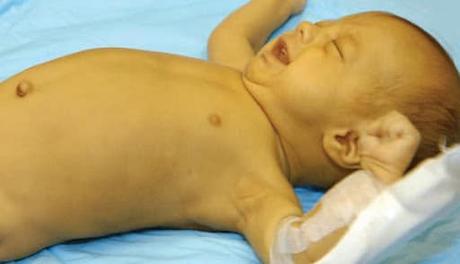
Jaundice (also known as icterus) is defined yellowish pigmentation of the skin, the conjunctiva membranes over the sclera (whites of the eyes), and other mucous membranes caused by hyperbilirubinemia (increased levels of bilirubin level in the blood). Newborn jaundice is a yellowish color of baby skin and eyes. It is very common in neonatal and can occur when babies have a high level of bilirubin level, a yellow pigment produced during normal breakdown of red blood cells in body. In older babies and adults, the liver processes bilirubin, which then passes through the intestinal tract. However, in newborn’s the liver still-developing and may not be mature to remove bilirubin in the body. In most cases, newborn jaundice goes away on its own as a baby’s liver develops, and which helps bilirubin pass through the body. In most cases, jaundice will disappear within two to three weeks. Jaundice that stay longer than three weeks may be a symptom of an underlying condition. High levels of bilirubin can put a baby at risk for deafness, cerebral palsy, and other forms of brain damage.
PATHOPHYSIOLOGY OF JAUNDICE
- Bilirubin mainly originates from heme via the catalyzation of heme oxygenase (HO) and biliverdin reductase and is conjugated into direct form by UDP-glucuronosyl transferase (UGT1A1) for subsequent biliary secretion.
- Jaundice occurs when conjugated or unconjugated bilirubin deposits onto the skin and it is very common during the neonatal period. Neonatal jaundice is related to physiologic and pathologic conditions.
- Physiologic aspects are comprised of increased bilirubin production, less efficient hepatic conjugation and enhanced enter hepatic circulation. In pathologic condition, there are two patterns of diseases that is hyperbilirubinemia and cholestasis.
- In hyerbilirubinemia there is accumulation of unconjugated bilirubin beyond the extent of physiologic jaundice, while cholestasis results from the excretory obstruction of conjugated bilirubin. Neonatal hyperbilirubinemia carries a potential risk of kernicterus, a long-term neurological impairment.
- Proper management is important to avoid the complications. The phototherapy and exchange transfusion is the management of neonatal jaundice.
AYURVEDIC APPROACH
- Nidana –
- According to Acarya Caraka, consumption of Pitadusta stanya (breast milk which is vitiated by pita) is the cause of yellowish discoloration of the skin which is explained under Ashtaksheera dosas. He also said that Pandu rogi consuming excessive Pittala Ahara is the root cause of Kamala.
- According to Acarya Susruta, Kamala is considered as a synonym of Panduroga due to Aparityaga (not treated) of Panduroga.
- Acarya Vagbhata said that, kamala is caused by Atyartha pittala ahara sevana by a Pandu rogi or by a pitala person it leads to Kamala.
- Madava Nidana, Yogaratnakara and Bhava prakasha also said that Pitadusta stanya is the cause of Kamala.
- Purva rupa –
- Separate Purvarupas of Kamala has not been mentioned by acharyas. According to Acharya Caraka, Kamala represents a state of Pandu roga with different symptoms whereas Acharya Susrutha do not explain about Purvarupas kamala.
- Rupa –
- Charaka samhitha describes the Lakshanas as yellowish discoloration of eye, nail and urine.
- Samprapti –
Raktavaha srotas dushti > Vridi and sancaya of Mala roopa pitta > Sthana samshraya in Twak, Rakta and Mamsa > Navajata shishu kamala
SIGN AND SYMPTOMS OF JAUNDICE
- Yellow discoloration of the skin, mucous membranes and sclera
- Poor feeding
- Lethargy or excessive sleepiness
- Changes in muscle tone
- High-pitched crying
- Seizures
- Yellow color inside the mouth
- Dark or brown-colored urine
- Pale or clay-colored stools
TREATMENT IN AYURVEDA
- LIVER CARE SYRUP – Liver Care syrup helps in balancing Pitta dosha. This Syrup enhances regeneration of liver cells, promote functions of liver, and improve blood flow from the liver. It helps in the treatment of fatty liver, liver cirrhosis, Hepatitis, hepatomegaly, and obstructive Jaundice. CAC Liver Care syrup contains Ingredients like Kalmegh (Andrographis paniculata), Kutaki (Picrorhiza kurroa), Bhumi amla( phyllanthus niruri), Giloy(Tinopora Cordifolia), Yavakshar( Hordeum vulgare), Imli Kshar( Tamarindus indica), Mukta Shukta pisti etc. These herbs show Antioxidant, anti-inflammatory, Hepato-protective, properties. This syrup improves digestion, enhances appetite.
Recommended Dosage: Take 1 teaspoonful’s twice daily.
- Liver care tablet – These tablets are 100% safe and purely ayurvedic formulation. It maintains the proper functioning of the liver and stimulates the growth of new liver cells. Liver Care Tablets contains Ingredients like Kalmegh (Andrographis paniculata), Kutaki(Picrorhiza kurroa), Bhumi amla( phyllanthus niruri), Giloy(Tinopora Cordifolia), Yavakshar( Hordeum vulgare), Imli Kshar( Tamarindus indica), Mukta Shukta pisti etc. These herbs balances excess Pitta Dosha and helps in problems like abdominal bloating,flatulence, abdominal pain, loss of appetite and indigestion.
Recommended Dosage – Take 1/2 tablet twice daily with normal water.
- Immune up powder – Immuno up sachet is pure herbal formulation. The importance of working on your immunity is now on an all-time high. If a person fall ill easily, it means their body’s immunity is low. This pacifies tridosha (Vata, pitta and Kapha), strengthen your immunity, keeps your digestive system fit and also detox your body. It also works in cold, fever and flu conditions. It consists of effective levels of antioxidants, Vitamin C and E which circulate in the body to protect it against the damage caused by free radicals. It is a natural immune-modulator properties to prevent and ease coughing, sneezing, etc. It provides quick relief from early signs of running nose, Sore throat, body pains, and weakness.
Recommended Dosage – Take 1 sachet in a day with water.
- Rasayan vati – Rasayan vati is herbo-mineral ayurvedic formulation, which is 100% natural. Rasayan vati contains various herbs such as Aswagandha, Shilajeet, Amla, Kesar, Musali, Shatavar, Brahmi Abhrak Bhasam, Swarn Makshik Bhasam, Yashad Bhasam, Mukta pisti, Praval pisti, Jaiphal, Vang Bhasam, Dalchini, Javitri, Gokhru, Kaunch Beej, Saunth, Mirch, Pipli, Amla, Kesar, Manjith, Anant Mool, Brahmi, Musali, Swarn Vang, etc. These ingredients show antioxidant, aphrodisiac, anti-inflammatory, antipyretic, analgesic, immuno-modulator properties. These tablets provide good results in General debility, Psychological disorders, and improves immunity.
Recommended Dosage – Take 1 tablet in a day with water.
